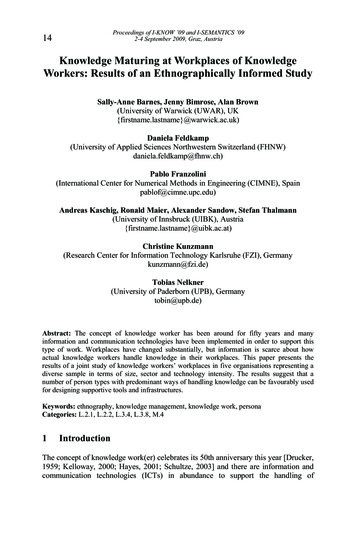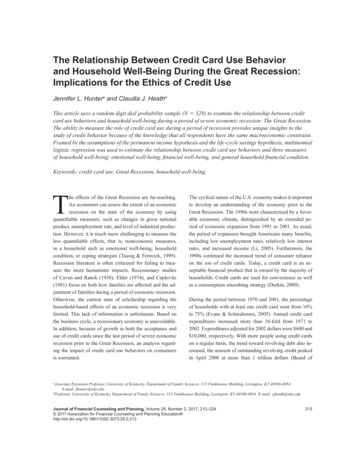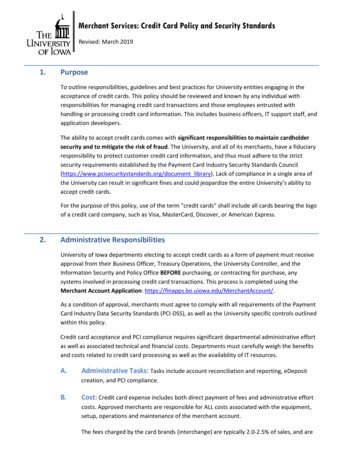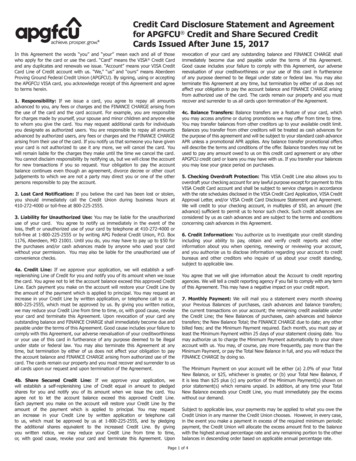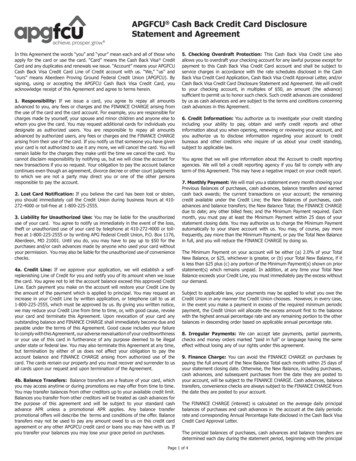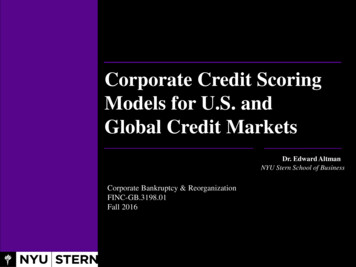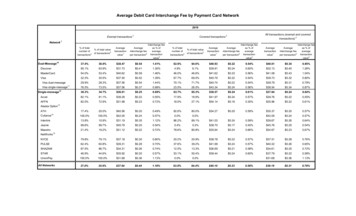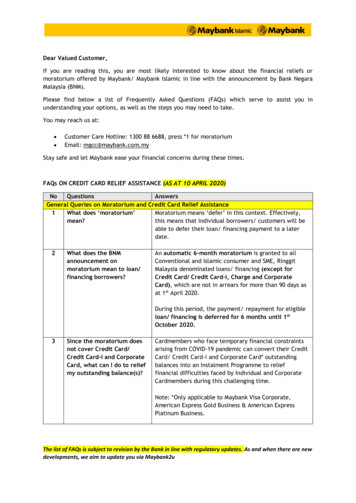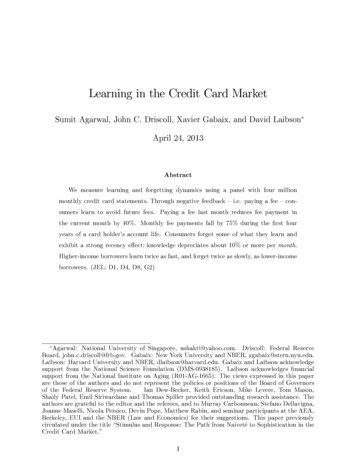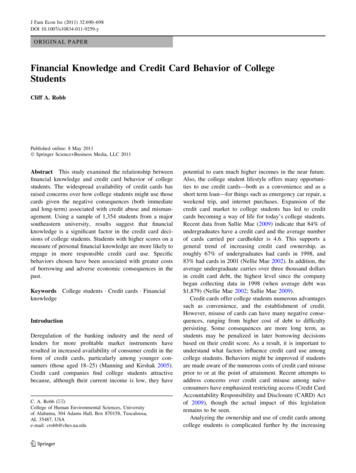
Transcription
J Fam Econ Iss (2011) 32:690–698DOI 10.1007/s10834-011-9259-yORIGINAL PAPERFinancial Knowledge and Credit Card Behavior of CollegeStudentsCliff A. RobbPublished online: 8 May 2011 Springer Science Business Media, LLC 2011Abstract This study examined the relationship betweenfinancial knowledge and credit card behavior of collegestudents. The widespread availability of credit cards hasraised concerns over how college students might use thosecards given the negative consequences (both immediateand long-term) associated with credit abuse and mismanagement. Using a sample of 1,354 students from a majorsoutheastern university, results suggest that financialknowledge is a significant factor in the credit card decisions of college students. Students with higher scores on ameasure of personal financial knowledge are more likely toengage in more responsible credit card use. Specificbehaviors chosen have been associated with greater costsof borrowing and adverse economic consequences in thepast.Keywords College students Credit cards FinancialknowledgeIntroductionDeregulation of the banking industry and the need oflenders for more profitable market instruments haveresulted in increased availability of consumer credit in theform of credit cards, particularly among younger consumers (those aged 18–25) (Manning and Kirshak 2005).Credit card companies find college students attractivebecause, although their current income is low, they haveC. A. Robb (&)College of Human Environmental Sciences, Universityof Alabama, 304 Adams Hall, Box 870158, Tuscaloosa,AL 35487, USAe-mail: crobb@ches.ua.edu123potential to earn much higher incomes in the near future.Also, the college student lifestyle offers many opportunities to use credit cards—both as a convenience and as ashort term loan—for things such as emergency car repair, aweekend trip, and internet purchases. Expansion of thecredit card market to college students has led to creditcards becoming a way of life for today’s college students.Recent data from Sallie Mae (2009) indicate that 84% ofundergraduates have a credit card and the average numberof cards carried per cardholder is 4.6. This supports ageneral trend of increasing credit card ownership, asroughly 67% of undergraduates had cards in 1998, and83% had cards in 2001 (Nellie Mae 2002). In addition, theaverage undergraduate carries over three thousand dollarsin credit card debt, the highest level since the companybegan collecting data in 1998 (when average debt was 1,879) (Nellie Mae 2002; Sallie Mae 2009).Credit cards offer college students numerous advantagessuch as convenience, and the establishment of credit.However, misuse of cards can have many negative consequences, ranging from higher cost of debt to difficultypersisting. Some consequences are more long term, asstudents may be penalized in later borrowing decisionsbased on their credit score. As a result, it is important tounderstand what factors influence credit card use amongcollege students. Behaviors might be improved if studentsare made aware of the numerous costs of credit card misuseprior to or at the point of attainment. Recent attempts toaddress concerns over credit card misuse among naı̈veconsumers have emphasized restricting access (Credit CardAccountability Responsibility and Disclosure (CARD) Actof 2009), though the actual impact of this legislationremains to be seen.Analyzing the ownership and use of credit cards amongcollege students is complicated further by the increasing
J Fam Econ Iss (2011) 32:690–698costs associated with obtaining a college degree. Evidencesuggests that growth in the areas of family income, grantaid, and federal loans has not kept pace with the risingcosts of college (College Board 2009; Heller and Marin2002). These costs are borne by students and their families,and one method of covering excess debt costs that hasbecome all too common is the use of a credit card (orcards) (Baum and Sanders 1998). This increased relianceon debt has raised concerns that students will be faced witha greater debt burden in the long run. According to Draut(2005), ‘‘The rise in credit card debt combined with massive student loan debt means that 25 cents of every dollarof income goes to paying off debt The explosion in creditcard debt is linked to the earnings crisis hitting youngadults’’ (p. 12).A common response to these concerns over increasingdebt and credit card misuse among college students hasbeen the prescription of financial education. There has beensignificant debate among researchers over the role andeffectiveness of financial education in recent years, withsome arguing that providing financial education has beenlargely ineffective (Willis 2008) and others arguing thateducation has many positive outcomes (Fox et al. 2005;Scott 2010). Using a sample of college students, the presentstudy asks the question of whether or not more knowledgeable students differ in their overall credit card usebehaviors when compared with less knowledgeable students. Previous studies have indicated differences inoverall debt load and balance behavior based on financialknowledge (Robb and Sharpe 2009). The analysis builds onthis work by examining different credit card behaviorsbeyond debt level and the decision to revolve, and placesspecific emphasis on credit card behaviors that have beenlinked with future financial difficulties and financial wellbeing in previous studies (Gutter and Copur 2011).Declines in the US saving rate (reaching near zero andnegative levels in recent years) have raised concern overAmericans’ willingness to rely on debt instruments as ameans of financing unrealistically high levels of living(Bureau of Economic Analysis 2008). College students arein a unique economic position because they are typicallyfaced with a modest current income stream with significantly higher expected earnings after graduation. Thepresent research should provide unique insight into thepotential relationship between credit card use and financialknowledge. Such findings may serve to justify or informorganized financial education programs at the college level.Literature ReviewThe development of the credit card market for collegestudents has been well documented (Kara et al. 1994;691Lyons 2004; Manning and Kirshak 2005; Nellie Mae 2002,2005; Sallie Mae 2009). Whereas statistics from NellieMae (2005) had been suggestive of declining credit carduse among undergraduates (rates had fallen from 83% in2001 to 76% in 2004), recent data show an increasingreliance on credit cards by college students, with roughly84% of all undergraduates reported holding at least onecredit card and an average balance level of 3,176 (SallieMae 2009). It is unclear whether these trends are the resultof recent economic troubles or whether they are moresuggestive of a continuing shift towards a culture ofcredit card ownership and acceptance of debt (Pinto et al.2001a, b).College Student Credit Card UseGiven the high rates of credit card possession among college students, many researchers have sought to understandmore about how students use their cards. Roberts and Jones(2001) developed a 12-item scale of credit card use thatindicated the degree to which students use their cardsresponsibly. These authors used the scale to analyzecompulsive buying behavior among college students, withthe idea that credit card use might have a moderating effecton the relationship between money attitudes and compulsive buying.Earlier research suggested that credit cards may serve asspending stimuli, encouraging individuals to spend morethan they would if a credit card was not available (Feinberg1986; Ritzer 1995). Research by Roberts and Jones (2001)supported these findings, suggesting that credit card usageserved as a mediator in many cases. Specifically, theresearch indicated that greater credit card use was associated with a stronger relationship between money attitudesand compulsive buying behavior, demonstrating a facilitating effect on the part of credit cards (Roberts and Jones2001).College students are a unique population in a sense.Worthy et al. (2010) found that how students handled creditcards and other financial responsibilities was related totheir adult status (the degree to which students may bedefined as adolescents, emerging adults, or adults) andsensation seeking, among other variables. Research hasindicated that individuals between the ages of 18 and 25 areoften in a state of transition between adolescence andadulthood, and many may be considered emerging adults.Worthy et al. (2010) indicated that emerging adults tend totake greater risks, and display less stability in terms of theirfinances, emotions, relationships, and cognitive development, and accordingly, such students were more likely tomisuse credit cards.Despite these characteristics, research suggests thatcollege students tend to use credit cards responsibly123
692(Kidwell and Turrisi 2000; Lyons 2004; Norvilitis andSanta Maria 2002). However, a significant portion of students engages in risky credit card behaviors that can havelong-term implications for their financial well-being(Gutter and Copur 2011; Lyons 2004).Financial KnowledgeEvidence from previous research suggests that collegestudents do not possess a high degree of personal financialknowledge, regardless of how knowledge is operationalized for the analysis (i.e. whether students are tested ongeneral knowledge of topics in personal finance orknowledge pertaining to their own credit cards) (Avardet al. 2005; Chen and Volpe 1998; Jones 2005; Markovichand DeVaney 1997; Warwick and Mansfield 2000). Inalmost every previous study, college students earn whatwould be considered a failing grade (less than 60% correct). However, despite this clear lack of financial knowledge, the majority of college students appear to behaveresponsibly when it comes to credit card use (Lyons 2004).Specifically, Lyons noted that more than half of the students sampled in the analysis reported paying off the balance in full each month (i.e. over half were convenienceusers), with relatively small percentages reporting significant revolving balances of over 1,000 (14–16%) and 3,000 (5%). Further, whereas college students are lackingin financial literacy, findings suggest that they are roughlyas knowledgeable as the rest of the adult population(Braunsberger et al. 2004).This general lack of financial knowledge prompted avirtual explosion of financial education programs in the USthroughout the 1990s, though specific issues covered andtarget audiences have varied significantly (Fox et al. 2005).While these programs have assisted researchers in developing a better understanding of the relationship betweenfinancial education and financial knowledge scores, theinitial proliferation of education programs has been criticized for failing to collect data that are more outcomespecific in nature (Fox et al. 2005; Lyons 2005; Peng et al.2007). Specifically, questions remain as to the degree towhich knowledge actually influences behavior. Braunsteinand Welch (2002) cautioned that whereas research suggeststhat greater financial knowledge may result in more positive behaviors, simply providing education does not ensureimprovements. It is not enough for programs to improvefinancial knowledge if the influence of increased financialknowledge on consumer behavior is not fully understood.Knowledge and BehaviorEvidence regarding the link between personal financialknowledge and observed behaviors has been inconsistent,123J Fam Econ Iss (2011) 32:690–698and different findings are noted depending on the topic orpopulation of interest. Among the general population, thereis evidence that financial knowledge and financial behaviorare positively related. Hilgert et al. (2003) noted significantcorrelations between credit management scores and scoreson a composite measure of financial knowledge. Robb andWoodyard (2011) found that greater objective and subjective financial knowledge were associated with improvedfinancial behaviors among a sample of 1,488 adults, thoughthe relative impact of subjective (self-assessed) knowledgewas greater than that of objective knowledge.Research by Chen and Volpe (1998) was among the firstto provide evidence of a link between knowledge anddecisions among college students, though the link is tenuous at best, as it is reliant on hypothetical financialdecisions. Students were divided into more knowledgeableand less knowledgeable categories based on a 36 questionsurvey dealing with various aspects of personal finance.More knowledgeable students achieved higher scores onhypothetical spending, investment, and insurance decisionswhen compared with less knowledgeable students. Moreknowledgeable students were also more likely to keepfinancial records. Similar evidence has been noted in termsof credit card use. Focus group data suggested that morefinancially literate students were more likely to reportpaying their balance in full each month, and were lesslikely to own a credit card when compared with studentswho had lower financial literacy scores (Cude et al. 2006).Conflicting evidence has been noted, however. Anexploratory analysis of roughly 216 freshmen enrolled in auniversity in the Southeast indicated that there was noassociation between credit card debt behavior and knowledge based on a 6-question measure of financial knowledge(Jones 2005). Borden et al. (2008) presented similar resultsin their pilot study (N 93) of the Credit Wise Catseducation program. While their findings suggested that theprogram increased both financial knowledge and responsible attitudes toward credit, they did not indicate anysignificant relationship between financial knowledge andeffective or risky financial behaviors (Borden et al. 2008).While this provides evidence that financial education andenhanced knowledge may improve student intentionstowards more responsible behavior, it does not necessarilyindicate whether or not students follow through w
credit card market to college students has led to credit cards becoming a way of life for today’s college students. Recent data from Sallie Mae (2009) indicate that 84% of undergraduates have a credit card and the average number of cards carried per cardholder is 4.6. This supports a general trend of increasing credit card ownership, as roughly 67% of undergraduates had cards in 1998, and 83 .
